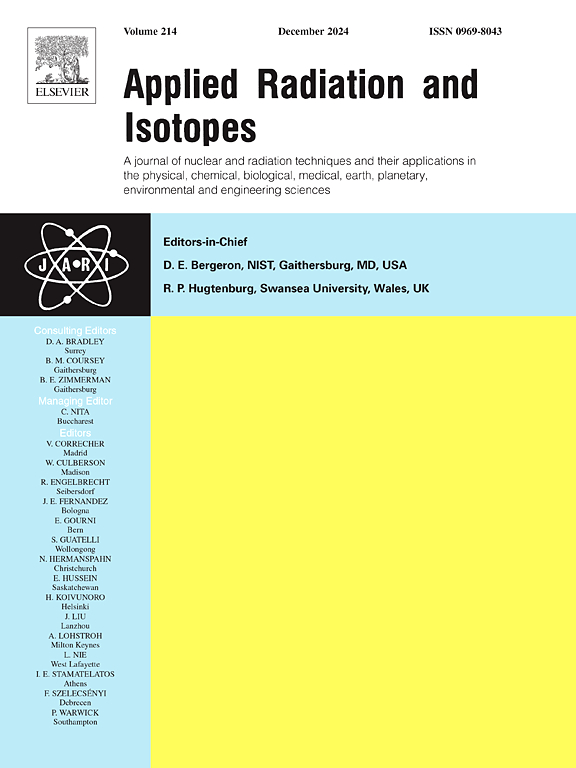在 ISOLPHARM 项目中,利用塞伦科夫发光成像技术和数字自动放射成像技术拍摄 111Ag 模型图像。
IF 1.6
3区 工程技术
Q3 CHEMISTRY, INORGANIC & NUCLEAR
引用次数: 0
摘要
靶向放射性核素疗法(TRT)是一种利用放射性核素对抗癌症生长和扩散的医疗技术。靶向放射性核素疗法需要供应目前由回旋加速器或核反应堆生产的放射性核素。在这种情况下,ISOLPHARM 项目研究了用于医疗应用的创新放射性核素的生产。这种生产将以即将在美国国家核物理研究所(INFN)莱格纳罗国家实验室(LNL)建成的 SPES 设施为基础,该设施是一个 ISOL 设施,将使用高纯度放射性束来生产无载体放射性药物。之前的研究表明,在 SPES 设施中可以获得大量 111Ag,这是一种创新的 β/γ 发射体,适用于治疗应用的 TRT。本研究介绍了 ISOLPHARM 合作项目对 111Ag 模型进行的首次成像研究。这是为目前正在开发的基于 111Ag 的放射性药物即将进行的体内研究铺平道路的重要一步。通过利用塞伦科夫发光成像技术(CLI)和数字自动放射成像技术(ARG)获取模型图像,研究了这种放射性核素的成像潜力。本文章由计算机程序翻译,如有差异,请以英文原文为准。
111Ag phantom images with Cerenkov Luminescence Imaging and digital autoradiography within the ISOLPHARM project
Targeted Radionuclide Therapy (TRT) is a medical technique exploiting radionuclides to combat cancer growth and spread. TRT requires a supply of radionuclides that are currently produced by either cyclotrons or nuclear research reactors. In this context, the ISOLPHARM project investigates the production of innovative radionuclides for medical applications. This production will be based on the forthcoming SPES facility at the Legnaro National Laboratories (LNL) of the National Institute for Nuclear Physics (INFN), an ISOL facility where high-purity radioactive beams will be used to produce carrier-free radiopharmaceuticals. Previous studies demonstrated that a significant amount of 111Ag, an innovative / emitter suitable for TRT with theranostic applications, can be obtained at the SPES facility. The present work describes the first imaging study on phantoms with 111Ag performed by the ISOLPHARM collaboration. This is a fundamental step to pave the way for the upcoming in vivo studies on the 111Ag-based radiopharmaceutical currently being developed. The imaging potential of this radionuclide was investigated by acquiring phantom images with Cerenkov Luminescence Imaging (CLI) and digital autoradiography (ARG).
求助全文
通过发布文献求助,成功后即可免费获取论文全文。
去求助
来源期刊

Applied Radiation and Isotopes
工程技术-核科学技术
CiteScore
3.00
自引率
12.50%
发文量
406
审稿时长
13.5 months
期刊介绍:
Applied Radiation and Isotopes provides a high quality medium for the publication of substantial, original and scientific and technological papers on the development and peaceful application of nuclear, radiation and radionuclide techniques in chemistry, physics, biochemistry, biology, medicine, security, engineering and in the earth, planetary and environmental sciences, all including dosimetry. Nuclear techniques are defined in the broadest sense and both experimental and theoretical papers are welcome. They include the development and use of α- and β-particles, X-rays and γ-rays, neutrons and other nuclear particles and radiations from all sources, including radionuclides, synchrotron sources, cyclotrons and reactors and from the natural environment.
The journal aims to publish papers with significance to an international audience, containing substantial novelty and scientific impact. The Editors reserve the rights to reject, with or without external review, papers that do not meet these criteria.
Papers dealing with radiation processing, i.e., where radiation is used to bring about a biological, chemical or physical change in a material, should be directed to our sister journal Radiation Physics and Chemistry.
 求助内容:
求助内容: 应助结果提醒方式:
应助结果提醒方式:


